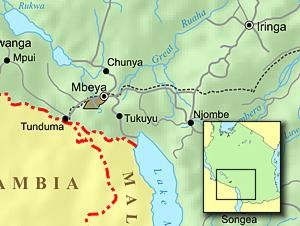
Population: 70,000
Location: Mbeya Region
Altitude: 2000 metres
Alternate names: Kimalila
The Malila: The Malila live high in the mountains in the Mbeya Region of Tanzania. Their culture and language are well-preserved and the Malila are proud of their heritage. They place a high value on hospitality and are known to go above and beyond the call of duty to make sure that guests are properly taken care of.
One of the customs for those who follow the traditional beliefs is to carry the bodies of their deceased to all the places they went while they were still alive. It is believed that this provides someone who has died with a proper chance to say goodbye.
The Malila are warm, hospitable people. They are excited to get the Word of God in their mother tongue.
Location within Country: Mbeya Region, about 40 km southwest of the town of Mbeya. South of Safwa, north of Ndali, west of Nyakyusa, east of Nyiha.
Geography and Climate: Savannah and tropical forest. They live high in the mountains where the temperature can drop to 42° F. The climate is perfect for farming -they have moisture in the form of dew all year round.
Cultural Information: The Malila have been somewhat isolated from other groups due to the geographic location, which is not easily accessible, but the area is rich agriculturally. The Malila are very hard working. Their fields stretch as far as one can see, and all their work is done by hand. Their crops consist of: maize, potatoes, sweet potatoes, peas, beans, millet, and some wheat. Cash crops include coffee and pyrethrum. Due to adequate rainfall the people can harvest up to three times per year. They have enough food for their daily lives and get money from selling their harvests in Santilya, a local market town.
Health: There is very little malaria due to the high altitude but diarrhea is a large health concern for the Malila people.
Language Group Information: A sociolinguistic survey in the Malila area was conducted by the Language Assessment team in 2003. The conclusions from this research were as follows:
- The Malila language is clearly vital. It is the dominant language in the Malila society in all domains other than in education and church, and is the main language among the children.
- All four groups interviewed said that the Malila all speak the same language throughout the area. They all agreed that the use of Swahili in their communities was low. One estimated that only 25% of the population truly knows Swahili.
- All the church leaders agreed that there were people in their congregations who do not understand everything when Swahili is used.
- Within the Malila community, the Malila language is strongly vital and has high prestige. There are no indications of language shift to another language. Ilembo is the village that should be used as reference dialect.
The Malila are a very close-knit group and almost exclusively use their own language. This is due to the fact that the area is not easily accessible. Their language is very much alive and despite being educated in Swahili, the national language, many cannot speak it well. The Malila travel little and many people have never been as far as Mbeya town. They preserve their language and their culture much more than some other people groups.
Religion: Christian, traditional religion. There is a growing church in the Malila area but many pastors are having difficulty preaching from a Swahili Bible. They often preach in Malila but cannot read the Bible in Malila as it does not exist. They are longing for the Word of God in their language. Now work has begun in order to help them to get it. Strong evangelistic efforts in the region by the churches have resulted in numerous Christians.
The Malila Church: There was an overwhelming consensus among the church leaders that the Malila Bible is wanted and that they themselves would use it. A strong motivation is the lack of Swahili proficiency. Most churches use Malila regularly in their services but find it difficult, especially in worship, since the Bible can only be read in Swahili. Even those who did not know Malila themselves said that they would have the Malila Bible read and used in church, for evangelism, and even in their home. There is definitely a strong support from church leaders to having and using Malila Scriptures.
The Language Team: The team has members of MEC, Baptist and Salvation Army. The team is made up of Juma M., Lukas M. as translators, Majariwa M. as Literacy/SU coordinator and Samwell M. as back translator.
History: No previous language development has been attempted in Malila.
